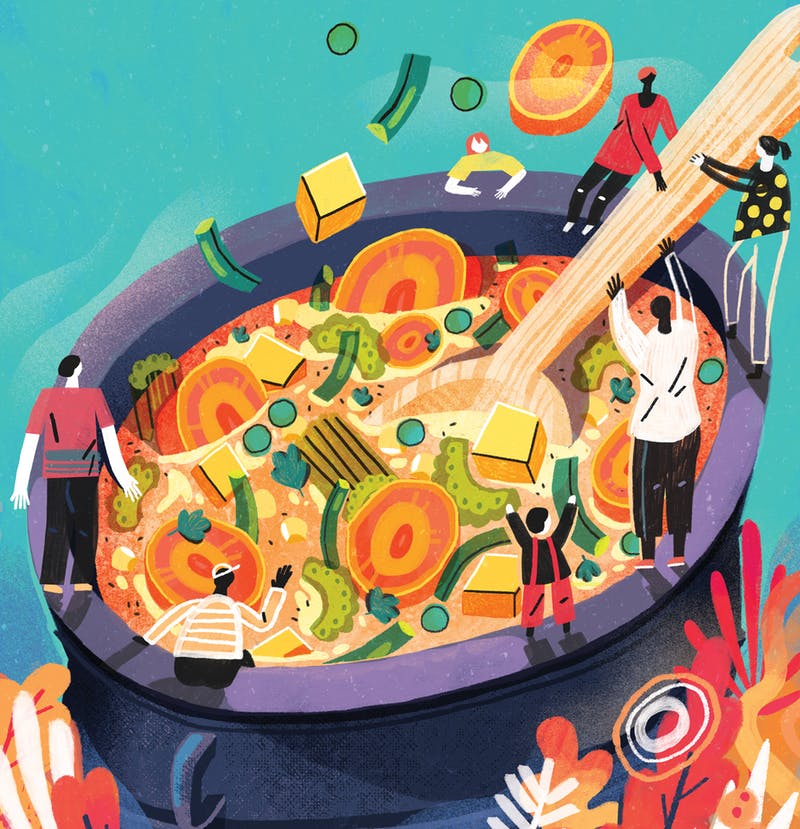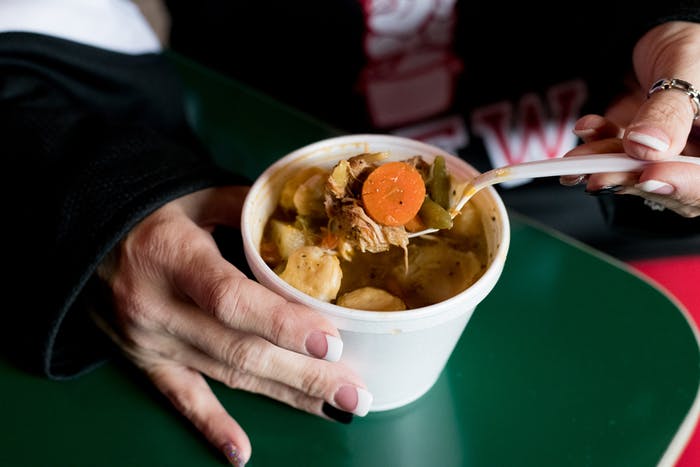Illustration: Wenjia Tang
We think we’re so cosmopolitan here in the Twin Cities. “Food World’s Best Kept Secret,” they say.
Still, most of us are mere city rats: clever, resourceful creatures, sure, but ones legendary for spending entire lifetimes rarely adventuring beyond reliable feeding destinations—which, these days, are crafted by Daniel del Prado.
But sometimes, between sleeping and scrounging and screaming about traffic, the clouds part and create a perfect beam of early autumn light, falling just so on the perimeter of ye olde trusty work parking lot. This fleeting moment of illumination catches on a hand-painted sign, seemingly from 1982. On it, one word screams like life itself:
BOOYA
As the leaves began to turn, Baader-Meinhof was in full effect. Hand-scrawled advertisements for upcoming “Booya Festivals” suddenly appeared to me everywhere. And, like all decent passwords, the word betrayed nothing of what it contained if one weren’t among the initiated.
For two actual weeks straight, I sounded like I was losing my mind, asking everyone I knew: “What is booya?”
Photo: Lucy Hawthorne
“Huh? No idea what you’re talking about.”
“You mean that thing Stuart Scott yelled?”
“Oh. It’s Minnesotan—short for ‘bouillabaisse.’” (Incorrect.)
“Never had it, but I swear it’s on the Billy’s Victorian marquee all year... like, they never take it down.”
Then, on the day of the Vikings home opener, two respondents familiar with the phenomenon finally materialized. The first—a friend’s father, standing in a garage, sipping Budweiser—proclaimed: “It’s not real booya unless it’s being cooked over an open flame, outdoors, while, ideally, being stirred by a canoe paddle.” Later that evening, a co-worker sent chills down my spine: “Ohhh, yeah. Awful stuff. It’s kinda like stone soup. My grandpa used to make my dad eat booya when he was growing up to [air-quoting] ‘make him like lutefisk more.’ He put dandelion leaves in his.”
“Booya” (sometimes spelled “booyah”) is a type of stew particular to Minnesota and the Upper Midwest, made in batches of up to 200 gallons at a time. (The word may have origninated from a mishearing of “buillon” in Wisconsin.) Most take a minimum of 12 hours to cook, and some as many as four days. The festival at which it’s served is also called a booya. Some combination of hearty, inexpensive vegetables, mild spices, and whatever meat is on hand are its building blocks, along with the occasional cracker. Plus, nowadays, a ubiquitous styrofoam bowl.
A lack of a set recipe owes directly to its age and origins. Like the Jucy Lucy, it’s impossible to say who made the first booya; Belgians, Hungarians, and sometimes French Canadians all lay claim to bringing booya to the United States.
Across the board, booya is the color of rust, and tastes like work—both everything that went into it, and that which is yet to be done. It’s the opposite of sexy. It tastes of the earth.
Having stumbled upon a calendar of booyas spanning September and October—one that, it’s worth noting, assumed readers already knew what they were in for and simply described the dish in question as “that thick, rich stew”—I set a course for the heart of a Minnesota culinary tradition. I hoped to discover what made this open secret tick, and why its fans were so rabid about... soup.
The first church booya I sampled came ladled from crock pots in a children’s gymnasium-slash-lunchroom, and was accompanied by stale saltines. It tasted exactly like Campbell’s vegetable soup, plus beef, minus spices.
“This is booya?! I was promised something flame-roasted, and the great autumnal outdoors!”
In shock, I stared blankly at an old TV that had been wheeled in to play the day’s Vikings game, seated at a long table draped in plastic, surrounded by salt and pepper shakers. Families were stocking up on this shit for the winter, taking it to-go.
As I tried to wrap my head around what was happening to me, a long-lost acquaintance materialized out of my sad mist, agreeing this booya was “too sweet,” and noting that “Highland has a good one.”
With that, I felt I’d been given permission to leave.
St. Paul’s resident villains, the Vulcans, provided a palate-cleanser to the piety of a church booya. Continuing their roll in the off-season from the Winter Carnival, they were easy to spot—perpetually decked-out as they (and their groupies) are in flame-red devil outfits—loitering in a cluster near Luverne the vintage fire truck in the parking lot behind Mancini’s Char House on West Seventh.
Photo: Lucy Hawthorne
Unlike the holy folk, the Vulcans themselves didn’t make their booya, but rather employed the Booya Crew, second-generation booya makers whose recipe featured ground turkey and pork, as well as the usual potatoes, carrots, tomatoes, green beans, and onions.
The Vulcan taking our five-buck fee pointed out how little fat there was floating on top of our bowls, and its lack of oxtail (“my wife won’t eat it if there’s that stuff in it”). They’d already blazed through 185 of the 200 gallons they’d started with only hours before. All together, it tasted like chicken noodle soup... weird, considering no one mentioned the presence of chicken, and there were zero noodles.
Everyone drank beers and booze; it was a tailgate, not for sport, but for soup. “If it weren’t for the cult vibes,” I thought, “this is how I’d pictured a booya!”
After trying to save the planet by encouraging attendees to bring their own “tupperware,” Bent Brewstillery earned the unique distinction of hosting the only booya to receive a Cease and Desist Order from Tupperware Corp., ensuring that their truly spicy, actually delicious booya was doled out in styrofoam bowls just like its brethren. Simmering over a propane flame and stirred with what could well have been a proper canoe paddle, the booya was full of cabbage, potato, corn, chicken, roast pork, and spicy andouille sausage that the masters had begun chopping the night before.
“We have salt and pepper, but you won’t need it,” they said, as I bought a bowl. And, for the first time in the history of the state of Minnesota, they were right. The cabbage offered a welcome bitterness and tooth, with corn kernels that popped in your mouth like landlocked caviar. The potatoes held together, separating the broth from its filler. Proper andouille heat was perfectly tempered by tender, pulled chicken.
But this last element also made it unlike any booya before or after, which prompted me to wonder: “Is using Cajun sausage, making Minnesota reckon with actual spiciness, cheating in the world of Collective Northern Stew?”
Inspired by a streak of hits, and the sheer variety of booya in the world, I thought I’d give another religious establishment a shot.
I should not have done this. Even more regrettably, I’d invited friends along.
This beef had been cooked to the point of becoming a textureless, flavorless mush-meat. There was zero broth, only a mass of solids in a container, due in no small part to the equal-chop of celery, potato, carrot, and green pepper—poor technique for an extended simmer. No crackers were offered, leaving no texture to be found. The concoction was unbearably sweet, perhaps due to the carrots having nearly completely dissolved.
With only nine quarts out of 80 gallons remaining, in the words of one poor soul whom I’d dragged along on the adventure: “The quantity of this sold is an indictment on humanity.” And yet, we reminded ourselves, the money raised would surely lead the church to flourish in unknown ways in the coming year.
Crawling out of the depths of misery, I dragged myself to the American Legion hall with dismal expectations. What I found instead was booya in its most perfect form, surrounded by creators who took time to bask in not only their achievements, but its history.
Sidling up to purchase a bowl, I asked my usual question of the woman doling it out, whom I’d come to know as Carol.
“What do you put in your booya? I know you can’t give away all the secrets...”
“Oh, the normal stuff.”
“Everyone’s normal is so different!”
“Corn, rutabaga, lima beans, carrot, cabbage, potatoes, tomato, spices, chicken legs, pork, oxtail...”
Members of the Booya Crew, second-generation booya makers who were behind the stew at several St. Paul festivals this year
“See, I’ve been going on a booya tour, and this is the first time I’ve heard rutabagas or oxtail—and I love both. Now I’m excited.”
“I thought you were bein’ funny. This is Polish-normal.”
Cafeteria tray in hand, I wandered off to a lonely end of a table. Wanting for neither salt nor pepper, and with nary a cracker to be found, I housed the bowl.
A bake sale flanked one wall, offering “pie w/ whip cream for $2.50” and “glass of milk $1.00,” while the room adjacent had a full bar. At tables running the length of the room, your respected aunts and grandparents partook in an afternoon drink while hollering at a friend for packing up the pie prematurely.
I decided to find Carol, who’d initially regarded me like an alien beamed in from space, to tell her just how much I loved it.
“This is, far and away, the best booya I’ve had.”
Her face lit up like a Christmas tree. “Really?”
Photo: Sarah Brumble
“I swear.”
“Oxtails is what makes it. That and the pickling spices.” Then she pointed across the table. “That’s the man responsible—Russ, or Russell.”
Turns out this recipe originated at the Polish club that once existed down the street; after it closed, the American Legion inherited its “rights.” A team of guys, headed by the aforementioned Russell, works in shifts for four straight days to make the 200-gallon batch sold just one day each year. By the fourth hour of their sale, only about 15 gallons remained.
As the ladies went back and forth with me about legendary booyas—“Have you tried the Silver Fox? Oh it’s so good, but they do it early, in August this year”; “Up north they use wild meat, like bear and squirrel, in their booya!”—the impenetrable nature of booya suddenly dawned on me.
As Carol’s knee-jerk, Minnesota-nice reaction betrayed, everyone’s booya is normal to them. It’s a dish built not to expand communities, but to sustain them from within, where security is guaranteed. It exists to be shared, and to bring people together. The $4- or $5-per-bowl price is always a fundraiser, with the biggest booyas (like the one at Highland) pulling in upward of $15,000 for their organizations in mere hours, thanks less to the mystery stew itself than to the camaraderie served on the side.
For so many of us in the Cities, existence consists of flitting from commitment to obligation, punctuated by an occasional trip to the newest hot spot.
Taking a detour into the world of booya felt like reconnecting with the foundation of society we forgot, or felt a little too comfortable leaving in the rearview: those things that fortified us, body and soul, when we were new here, less concerned with frippery than we were with making it through the winter, together.
(originally published here)



